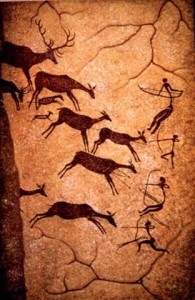
- Prehistoric Hunters in a Cave Painting
Vegetarians and vegans like to tell us that we should eat a largely carbohydrate diet. I disagree. They like to say that our diet should resemble that of gorillas and chimpanzees since they are supposedly our nearest evolutionary relatives. But our digestive systems are very different from theirs. Barry Groves explores those differences at length in an article on his site. Our digestive system resembles that of carnivores more than it does that of herbivores.
Dense carbohydrates are a very recent addition to the human diet. Agriculture did not occur until about 10,000 years ago; and in some areas such as northernEurope, agriculture did not arrive until about 5,000 years ago. Prior to that, humans were hunter/gatherers. Modern day hunter/gatherer diets tend to be largely meat-based with a preference for the fattiest portions. It is clear from the bone piles found at sites where prehistoric human remains have been found that the prehistoric diet included a lot of meat as well. Their cave paintings depict hunting, not agriculture. And the bones of those prehistoric humans showed that they were much healthier than us. They were taller, and they did not suffer from degenerative diseases such as arthritis. Those in the northern climates particularly would have been eating a meat diet because the ice age would not have allowed much vegetation to grow.
On the other hand, arthritis, obesity, and heart disease are apparent in Egyptian mummies, a society where grains predominated.
References:
Barry Groves. Should all animals eat a high-fat, low-carb diet? (This article compares our digestive system with herbivores and carnivores.)

